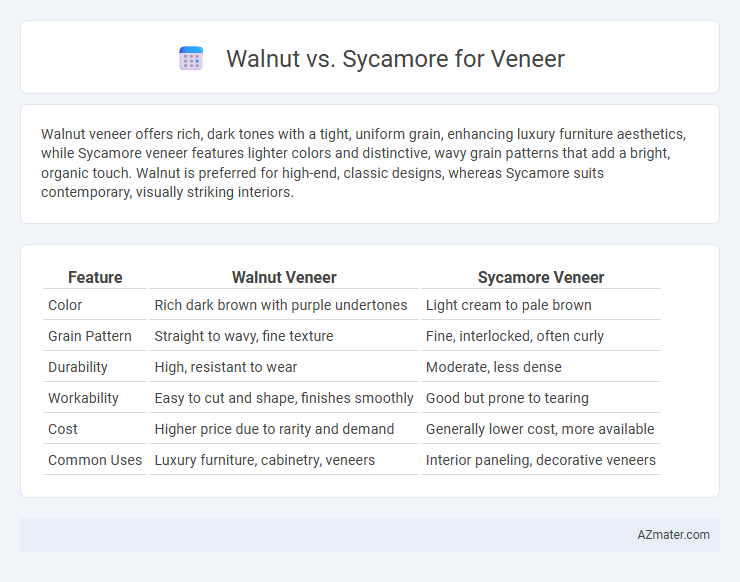Walnut veneer offers rich, dark tones with a tight, uniform grain, enhancing luxury furniture aesthetics, while Sycamore veneer features lighter colors and distinctive, wavy grain patterns that add a bright, organic touch. Walnut is preferred for high-end, classic designs, whereas Sycamore suits contemporary, visually striking interiors.
Table of Comparison
| Feature | Walnut Veneer | Sycamore Veneer |
|---|---|---|
| Color | Rich dark brown with purple undertones | Light cream to pale brown |
| Grain Pattern | Straight to wavy, fine texture | Fine, interlocked, often curly |
| Durability | High, resistant to wear | Moderate, less dense |
| Workability | Easy to cut and shape, finishes smoothly | Good but prone to tearing |
| Cost | Higher price due to rarity and demand | Generally lower cost, more available |
| Common Uses | Luxury furniture, cabinetry, veneers | Interior paneling, decorative veneers |
Overview of Walnut and Sycamore Veneers
Walnut veneer is prized for its rich, deep chocolate brown hues with subtle purple undertones, showcasing a smooth grain pattern that enhances luxury furniture and cabinetry. Sycamore veneer offers a lighter, creamy appearance with fine, wavy grain and occasional birdseye figure, providing an elegant and bright aesthetic ideal for modern interiors. Both veneers deliver durability for high-quality woodworking, with walnut favored for warmth and sophistication and sycamore chosen for its brightness and unique textural appeal.
Botanical Origins and Tree Characteristics
Walnut veneer primarily comes from the Juglans genus, especially Juglans nigra (black walnut), known for its dense, fine-grained wood and rich, dark brown color with purple hues. Sycamore veneer is derived from the Platanus genus, particularly Platanus occidentalis, recognized for its lighter color, distinctive mottled grain, and coarse texture. Walnut trees grow slower, producing harder wood with pronounced durability, whereas sycamore trees grow rapidly, offering a softer, more pliable veneer ideal for varied design applications.
Visual Appeal: Color and Grain Patterns
Walnut veneer features rich chocolate-brown hues with occasional purplish undertones, offering deep, warm tones that enhance luxury interiors. Its fine, straight grain often exhibits beautiful waves or curls, creating sophisticated visual textures. Sycamore veneer displays a lighter, creamy beige to pale golden color with subtle reddish streaks and a fine, uniform grain that imparts a bright and clean aesthetic.
Durability and Hardness Comparison
Walnut veneer offers a Janka hardness rating of approximately 1,010, providing moderate durability suitable for furniture and decorative surfaces. Sycamore veneer, with a slightly lower Janka hardness of around 950, is softer but still durable enough for interior applications. The harder walnut is more resistant to dents and wear, making it preferable for high-traffic areas, while sycamore's lighter weight and texture suit less demanding environments.
Workability for Veneer Production
Walnut offers excellent workability for veneer production due to its fine, even grain and moderate hardness, allowing for smooth slicing and minimal blade wear. Sycamore, with its interlocked grain and slightly coarser texture, can be more challenging to veneer but yields visually striking patterns when successfully processed. Both species benefit from careful moisture control during peeling to prevent splitting and ensure high-quality veneer sheets.
Common Uses in Interior Design
Walnut veneer is prized for its rich, dark brown hues and intricate grain patterns, making it ideal for luxury furniture, cabinetry, and wall paneling in upscale interior design. Sycamore veneer, with its lighter, creamy tones and subtle grain, is commonly used for modern, minimalist interiors, including decorative panels, shelving, and accent pieces that require a soft, natural look. Both veneers offer durability and aesthetic appeal but serve distinctly different design purposes based on their color and texture profiles.
Cost and Availability Factors
Walnut veneer typically carries a higher price point due to its rich color, grain, and slower growth rate, making it a premium choice in woodworking projects. Sycamore veneer is generally more affordable and widely available, as sycamore trees grow quickly and in larger quantities, ensuring consistent supply. Cost-effectiveness and ease of procurement often make sycamore a favored option for budget-conscious applications without sacrificing aesthetic appeal.
Environmental Impact and Sustainability
Walnut veneer, sourced primarily from slow-growing hardwood trees, often raises sustainability concerns due to its longer regeneration cycle and higher ecological footprint compared to sycamore. Sycamore veneer derives from faster-growing, more abundant trees, promoting better forest management practices and reducing the risk of deforestation. Choosing sycamore veneer supports sustainable forestry initiatives by minimizing habitat disruption and improving carbon sequestration relative to walnut.
Maintenance and Longevity
Walnut veneer offers moderate maintenance with a need for regular dusting and gentle cleaning using mild products to preserve its rich, dark finish. Sycamore veneer is generally low-maintenance, resistant to warping and moisture, making it ideal for humid environments and reducing the frequency of upkeep. Over time, walnut veneers develop a desirable patina that enhances their longevity, while sycamore veneers maintain a stable, light appearance with excellent durability against everyday wear.
Choosing the Right Veneer for Your Project
Walnut veneer offers rich, dark tones and intricate grain patterns ideal for high-end furniture and decorative applications, while sycamore veneer provides a lighter, more uniform appearance suited for modern and minimalist designs. Consider walnut veneer for projects requiring a luxurious, warm aesthetic with durable hardwood properties, whereas sycamore is preferred for cost-effective solutions that maintain strength with a subtle elegance. Assess the project's style, budget, and desired durability to select the veneer that best balances visual impact and functional needs.

Infographic: Walnut vs Sycamore for Veneer
 azmater.com
azmater.com